Arm Announces Mobile Armv9 CPU Microarchitectures: Cortex-X2, Cortex-A710 & Cortex-A510
by Andrei Frumusanu on May 25, 2021 9:00 AM EST- Posted in
- SoCs
- CPUs
- Arm
- Smartphones
- Mobile
- Cortex
- ARMv9
- Cortex-X2
- Cortex-A710
- Cortex-A510
A new CI-700 Coherent Interconnect & NI-700 NoC For SoCs
Finally, the last new announcement of the day is a new interconnect and network-on-chip generation. The last time Arm had announced a mobile/client interconnect was back in in 2015 with the CCI-550. The reason for the large gap between IPs, in Arm’s own words, is that ever since Arm’s introduction of the DSU in its CPU complexes, there really hasn’t been any need for a cache coherent interconnect in the market. While that’s eyebrow-raising from a GPU perspective, it makes perfect sense from a CPU perspective, as coherency between CPU cores was the primary driver for such interconnects until then.
With the advent of new more complex computing platforms, such as NPUs, accelerators, and hopeful more use of GPUs in cache-coherent fashions, Arm saw a need gap in its portfolio and decided to update its client-side interconnect IP.
The new CI-700 is a mobile and client optimised variant of Arm’s infrastructure CMN mesh network, implementing important new interoperability with the new IP announced today, such as the new DSU or CPU cores.
The new mesh interconnect scales up from 1 to 8 DSU clusters, and supports up to 8 memory controllers, and also introduces innovations such as a system level cache.
The mesh network topology and building blocks is very similar to what we’ve seen in the CMN infrastructure IP, in that “points” in the mesh are comprised of “cross-points” or “XP”. One differentiation that’s unique to the client mesh implementation is that XPs can have more attached connectivity ports, trading in routing connection paths. The new IP can also be configured as just a sole XP with no real mesh so to speak of, or essentially a 1x1 mesh configuration. This can grow up to a 4x3 mesh in the largest possible configuration.
The mesh supports from 1 to 8 SLC slices, with up to 4MB per slice for a total of 32MB, and snoop filter SRAM with coverage of up to 8MB address space per slice. It’s noted that generally Arm recommends 1.5-2x of coverage of the underlying private cache hierarchies of the mesh clients.
The SLC can server as both a bandwidth amplifier as well as reducing external memory/DRAM transactions, reducing system power reduction.
We see a reiteration of the support for MTE, allowing for this generation of IPs to support the feature across the new CPU IP, the DSU, and the new cache coherent interconnect.
Alongside the new CI-700 coherent interconnect, we’re also seeing a new NI-700 network-on-chip for non-coherent data transfers between a SoC’s various IP blocks. The big new improvements here is the introduction of packetization for data transfers, which leads to a reduction of wires and thus improves area efficiency of the NoC on the SoC.
Overall, the new system IP announced today is very interesting, but the one question that’s one has to ask oneself is exactly who these net interconnects are meant for. Over the last few years, we’ve seen essentially every major mobile vendor roll out their own in-house cache-coherent interconnect IP, such as Samsung’s SCI or MediaTek’s MCSI, and other times we don’t see vendors talk about their in-house interconnects at all (Qualcomm). Due to almost everybody having their own IP, I’m not sure what the likelihood would be that any of the big players would jump back to Arm’s own solutions – if somebody were to adopt it, it would rather be amongst the smaller name vendors and newcomers to the market. From a business and IP portfolio perspective, the new designs make a lot of sense and allows to have the building blocks to create a mostly Arm-only SoC, which is an important item to have on the menu for Arm’s more diverse customer base.


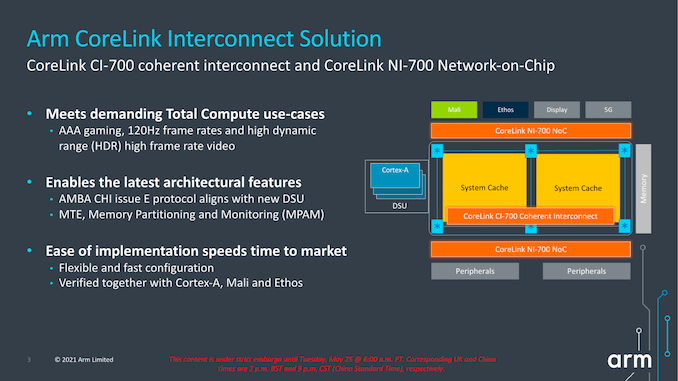

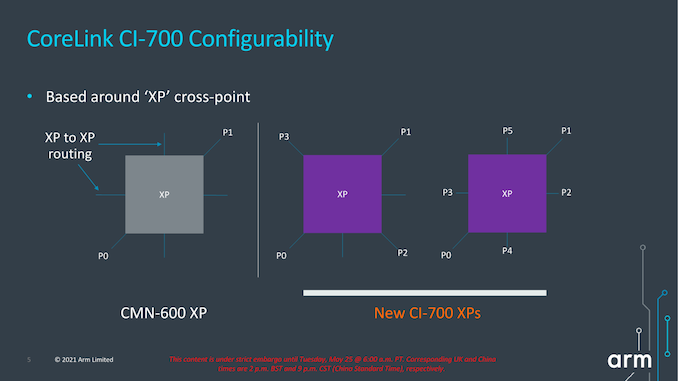
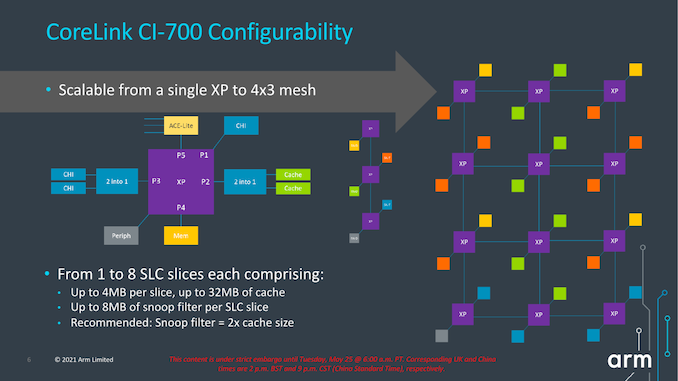
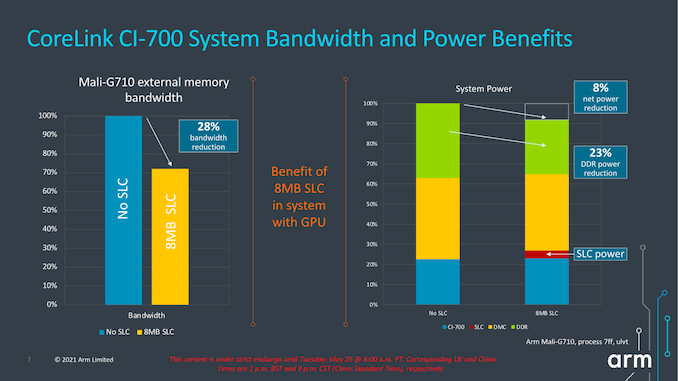
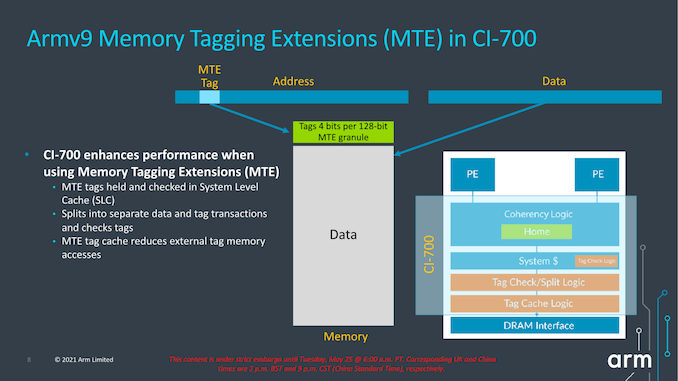









181 Comments
View All Comments
Fulljack - Wednesday, May 26, 2021 - link
that's why it's called DynamIQ, you know... as in "dynamic".phoenix_rizzen - Tuesday, May 25, 2021 - link
Interesting. Wonder if Samsung and/or Qualcomm will be using the A510 as the basis for a smartwatch SoC. A pair of these should provide a huge performance increase over the A7-based SoCs, but use much less power than anything using a "big" core (wasn't there a Samsung watch SoC that used a big core?).EthiaW - Tuesday, May 25, 2021 - link
An ideal mobile SoC configuration should be 2xX2+4xA710+2xA510. There is only so much background work to do and as many as four little cores do not make sense.Fulljack - Wednesday, May 26, 2021 - link
I'm thinking of 1×X2 + 3×A710 + 2×A510, and gives more room for GPU.docola - Tuesday, May 25, 2021 - link
question: does this mean if i buy a mobile phone today,that starting within a year from now it will eventually be useless because all
apps will be moving to 64 bit, which my phone wont support?
Or will my phone have access to plenty of the man 32 bit apps for 3-4 years to come?
(if thats the cas then i think i'll buy a stupidly cheap phone till next year)
thanks~
phoenix_rizzen - Tuesday, May 25, 2021 - link
Android phones have supported 64-bit OSes and apps since the Snapdragon 810, many many years ago.Android stopped accepting new 32-bit apps into the Play Store in 2019.
Android has essentially been 64-bit only for over 2 years now.
mode_13h - Wednesday, May 26, 2021 - link
> Android phones have supported 64-bit OSes and apps since the Snapdragon 810,> many many years ago.
You mean 8xx. I got a Nexus 5X in like 2015 that had a Snapdragon 808 with 2x A57 and 4x A53.
docola - Tuesday, May 25, 2021 - link
does the shift to 64 bit apps mean that todays phonewill start being unable to run apps next year?
Wilco1 - Tuesday, May 25, 2021 - link
No. Pretty much all phones are 64-bit today and thus support 64-bit apps already.Silver5urfer - Tuesday, May 25, 2021 - link
What's the use when all of these end up in planned obsolescence devices which have a max life of 2-3 years. They should make this "Days charging" whatever into reality by making the phones with removable batteries.As for laptops, same thing but different skin. Most of the BGA laptops will die fast because of their Heatsink and non replaceable components and high heat due to thin and light designs (mostly for x86) and then the Batteries for all those machines after market there's no way anyone can make use of their HW for more years, esp if the HW is all soldered. For eg an MXM laptop can take many generations of the GPUs it used to be the case for most machines until now since nowadays Turing based GPUs Quadro cards are also non standard.
So all in all get excited for same performance benefits that user will see, my SD835 phone is quick and fast and reliable yeah SD888 would be definitely faster but how much it would impact in the normal tasks of Maps / Browser / Videos / Music ? Games maybe but I don't play on smartphones. I presume it is same for all those SD855, 865 phones. Even the iPhones from A11 and up.
Bonus we don't get to control even 1 bit with hardcore locks on phones from OS level Filesystem nerfs from Goolag to the HW side of having no 3.5mm jacks and SD slots. But yea people love to get excited for new shiny stuff.